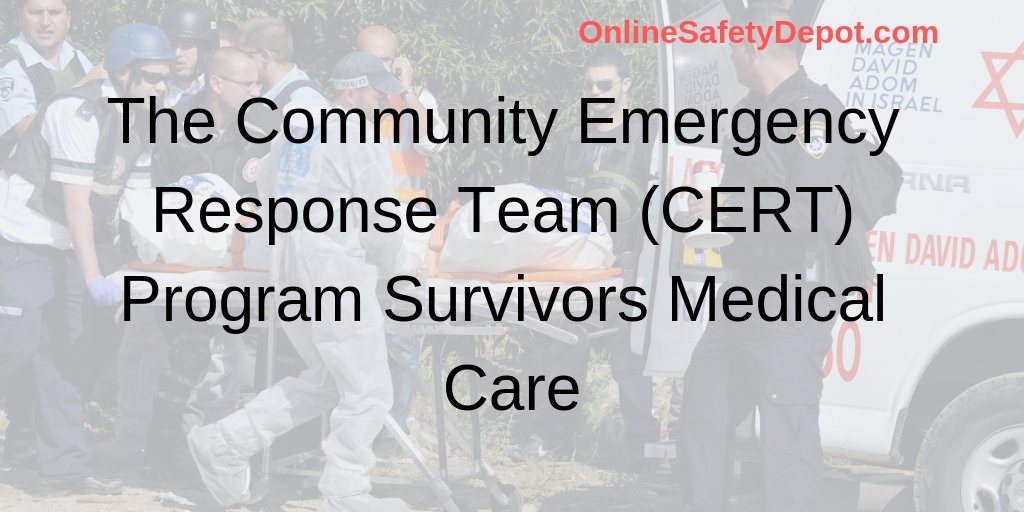The Community Emergency Response Team (CERT) Program Survivors Medical Care
Whether you are forced to experience natural disaster, terrorist attack, or have been called in to help others who have been affected by a disaster, knowing how to best help survivors is an important part of CERT training. After a disaster, providing appropriate medical care in a timely manner, is extremely important and may mean the difference between life and death. In this article, we will cover some basic first aid tips to help you better care for yourself, family members or others in your community that have been affected by the disaster. The goal is to provide sufficient medical care until professional help arrives.
People who take the Community Emergency Response Team (CERT) Program will be trained as first responders for their community in the event of a disaster, whether that be from an earthquake, flood, tornado, terrorist attack, or any other unexpected event.
When terrorist flew airplanes into the side do the Twin Towers on September 11th, 2001, survivors inside the building acted as first responders – they helped put out fires, applied pressure to bleeding wounds, carried injured people down the stairs where they were able to meet up with medical personal who were arriving at the scene. Safety and emergency response experts estimate that the death toll would probably have been much higher if it weren’t for the brave and immediate actions of the men and women who helped their friends and co-workers to safety.
To better help others, CERT members are instructed in a variety of skills that will enable them to better provide first responder aid to the victims. Consider these important skills and how they become extremely important to properly participate in helping those who have been caught up in a disaster or emergency.
1- Scene Size Up – the ability to look at an emergency situation – a flood, earthquake, bombing or some other event, and determine if it is safe to act and help others or the degree that you can and should act. Remember, your safety and those around you must come first. There may be times when you feel a need to help someone, but to do so is beyond your training or capabilities, or even equipment that you have.
2- Full body Assessment – the ability to assess the amount and type of injuries a victim has sustained to his or her entire body – from head to toe – making sure that nothing is missed in the assessment. Based on those findings the first responder would perform a triage of the survivors.
3- Triage Need Level of Survivors – the ability to prioritize those who need immediate medical attention above those who can wait. In essence, it is the ability to hierarchy, from immediate or critical need to conditions that can wait for a period of time; which victims to help based on the severity of their wounds or condition until medical care arrives. Triage can even include making tough decisions as to if a victim is beyond the care that can be provided in the field and will not live regardless of the efforts given to help them.
The triage hierarchy usually requires victims to be organized into these three groups:
- Extremely Critical: These are individuals who will die immediately due to the severity of their injuries. There is not much you can do for them other than comfort them and try and make them comfortable.
- Serious: These are individuals who will die within several hours from the time of injury. Most often associated with internal bleeding. Every hour that passes, their chances of survival diminishes.
- Injured but Stable: If left untreated, these are individuals who will die several days or weeks after the injury due to infections or other complications related to the injury.
4- First Aid – capable of performing CPR, basic wound care, offering emotional support, and other life-saving/life sustaining assistance.
5- Take Charge – having the ability, both physically and intellectually/emotionally to guide and direct organizational and interventional efforts to facilitate the evaluation, evacuation, and establishment of triage and treatment centers for all involved.
6- Emotional Support – be able to identify and help those who are struggling emotionally with the disaster, whether that be from a loved one who is hurt, a home that has been destroyed, or the shock of having endured a catastrophic event.
As a CERT member, your training is to help you better serve others, of course while also acting in a way that protects yourself. Helping others after a disaster can be dangerous (e.g., falling debris, loose floors, high waters, fires, etc.), demanding, stressful, and often requires the ability to anticipate the unseen dangers that could injure you and others you are working to serve and protect.
Personal Protection Equipment
CERT members are taught to use basic safety equipment such as gloves, goggles, durable and protective shoes, a safety helmet and a N95 rated filter mask. These basic protective items go a long way to protecting the responder from injury or from potential disease exposure, such as contaminants found in bodily fluids or other pathogens that may be harmful to your health. Because of these potential risks, knowing when to intervene and help or when to wait for trained personal or specific equipment to arrive is an important skill in and of itself.
Conclusion
Whether you are a survivor of a natural disaster or terrorist attack, having the skills to help yourself and others that are in need of help may just save someone’s life. Being a certified CERT member will allow you to be involved in your community and be a leader that others in our community will look to during those tough times.

